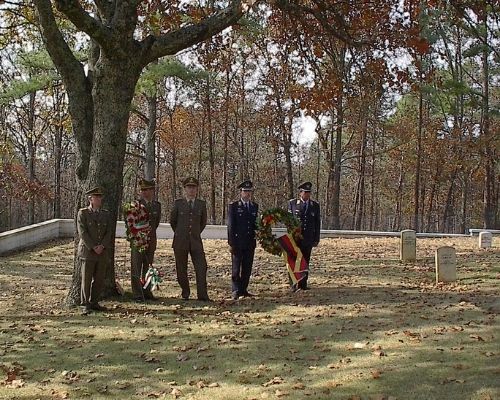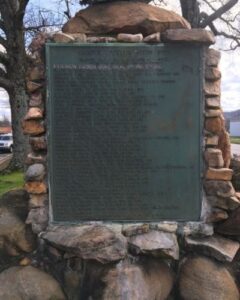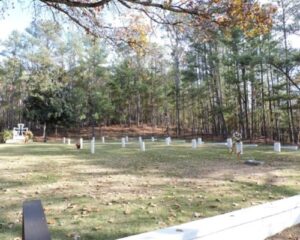
November 11, 2021
Kimberly O’Dell
November in America is always associated with thanksgiving and remembrance. While the tradition of thanksgiving has been around since the 1600s, honoring our military personnel only started in the 20th Century. At the start of the 20th Century, the Veterans of Foreign Wars (V.F.W.) was established to assist the servicemen who fought in the Spanish American War and Philippines Campaigns. The men who served in these conflicts were of a small number. In 1917, America came late to the First World War but still lost 4.7 million U.S. Servicemembers. After the Great War, the V.F.W. and The American Legion, a new organization chartered in 1919 by Congress, became partners to help servicemembers. While the main goal of these two organizations was assistance to the living, they were also instrumental in honoring those service members lost. Calhoun County had lodges for both the V.F.W. and the American Legion who were active in supporting returned veterans and honoring those lost. In 1921, Armistice Day, November 11th the day fighting ceased during the Great War in Europe, became a traditional day to honor military personnel.
 The monument, currently situated on Tenth Street and Quintard Avenue, is the World War I Veterans Memorial. This monument, which holds the bronze plaque with the Calhoun County Honor Roll, was dedicated on the first Armistice Day in 1921 by the Gold Star Mothers of the county. In 1925, the bronze eagle sitting on a globe was added to this memorial. The list of service members lost was compiled by Mrs. Joseph E. Aderhold; however, her list was incomplete and an additional plaque with omitted names was added to the monument recently. This statue is not to be confused with the Doughboy Statue in the 1200 block of Quintard Avenue that was dedicated on Memorial Day 1922 at what was then known as American Legion Park.
The monument, currently situated on Tenth Street and Quintard Avenue, is the World War I Veterans Memorial. This monument, which holds the bronze plaque with the Calhoun County Honor Roll, was dedicated on the first Armistice Day in 1921 by the Gold Star Mothers of the county. In 1925, the bronze eagle sitting on a globe was added to this memorial. The list of service members lost was compiled by Mrs. Joseph E. Aderhold; however, her list was incomplete and an additional plaque with omitted names was added to the monument recently. This statue is not to be confused with the Doughboy Statue in the 1200 block of Quintard Avenue that was dedicated on Memorial Day 1922 at what was then known as American Legion Park.
Armistice Day celebrations from the 1920s to the 1940s had a similar pattern. The American Legion Women’s Auxiliary made poppies to sell on the day. Schools were let out early in the city to attend the parades and events while county schools had an armistice day program of their own. Banks and other businesses were closed. A parade winded its way down Quintard, then a residential area. A program was prepared with patriotic readings and songs and an address generally by a politician were part of the day’s events. This day also included a flag dedication and for the 1932 Armistice Day, the flag was dedicated at Garner Hospital (502 Leighton Avenue). In 1947, the term Veterans’ Day was used for the first time but the name did not become official until a Congressional Act in 1954. Over the years, the Anniston Parade has moved from Quintard Avenue to Noble Street. Sadly, events have been scaled down and the day has turned into just another day off.
American Veterans are not the only soldiers honored in Calhoun County during the month of November. The third Sunday in November has become a day of remembrance for German and Italian Prisoners of War who died during World War II. How did Calhoun County become the final resting place for 29 German and Italian servicemen? In May 1943, 3000 German Prisoners of War were interned at Fort McClellan near the entrance to the current Baker Gate Road. No Italian Prisoners were interned at Fort McClellan. The German Prisoners were to live out the rest of the war in the Northeast Alabama Mountains. The camp was built in three sections each with 1000 prisoners. The POWs did their own cooking and maintenance. For entertainment, there were acting troupes, painting, newspaper reporters, soccer, and gardening to name a few activities. Much of the drainage work around the Buckner area was performed by the prisoner labor. These prisoner work details were assigned non-combat duties. When Cpl. Willi Waechter, who was on a work detail, was killed in a traffic accident in July 1943, a cemetery detail began construction on the POW Cemetery at Fort McClellan.
The German-Italian Prisoner of War Cemetery at Fort McClellan holds a total of 29 soldiers of which 26 are German and three are Italian. Only four of the 29 were buried at the cemetery while there was an active POW Camp. The remaining 25 men were brought from other prisoner of war camps in the Fourth Service Command. It was decided that after World War II, Fort McClellan would remain an active base so all POWs buried in the Fourth Service Command were brought to Fort McClellan and reinterned in the already established cemetery. These men died of everything from traffic accidents and suicides, to infections and brain tumors. The cemetery only has two officers both originally interned in Como, Mississippi in 1945: 1st LT Willie Fisher and Brigadier General Hans Schubert who was transferred from a to Kennedy Army Hospital in Tennessee where he had died of a brain tumor. The other internees were from Aliceville, Alabama; Rome, Georgia; McCain, Mississippi; and Como, Mississippi.
Just like in the United States, after World War I, Germans honored those who died in the armed forces and civilians who died in conflicts. The day of mourning is called Volkstrauertag (People’s Day of mourning) and is traditionally held two Sundays before Advent. The day was established by the German War Graves Commission in 1921. During World War II, no services were held in socialist Germany to honor Veterans on Volkstrauertag. It was only after the war, that West Germany again had services to honor the armed forces. November was also significant to the Italians to honor their soldiers as well. The Italians commemorate the end of World War I at the Battle of Vittorio Veneto on November 4th each year.
The services at the Fort McClellan POW cemetery to honor the fallen military personnel began in the mid-1950s thanks in part to one of the deceased soldier’s mothers. Mrs. Alice Rauschenberg, mother of Pvt Fredrich Rauschenberg, began the search for her son’s grave in the early 1950s. Fredrich had died in 1943 at the Aliceville Prisoner of War Camp in Pickens County, Alabama. After Mrs. Rauschenberg wrote numerous letters and contacted local Calhoun County officials, Fredrich’s grave was located on the post at Fort McClellan. In 1955, Alice Rauschenberg attended her first memorial service for her son and his comrades. Generally, the service was led by the Post Chaplain and the program included military songs, a prayer and speeches from local and military dignitaries.
Originally, West German and Italian soldiers stationed at Montgomery, Alabama bases traveled north to Fort McClellan to participate in the service each November. After Fort McClellan was closed in 1999, the cemetery came under the direction of Anniston Army Depot. The memorial service was continued with German and Italian service members from Huntsville, Alabama, traveling south to serve as the honor guard. In the years following the fort closure, many local citizens have volunteered their time to assist with the memorial service.
While the German-Italian Memorial Service still happens each year on the third Sunday in November, many have forgotten what Veteran’s Day is meant to remember. Parades and events no longer happen on Veterans’ Day in Calhoun County. So, on this November 11th, thank those who served and remember those who remained behind.
Sources:
U.S. Department of Veteran Affairs. The Origins of Veterans Day. Retrieved from https://www.va.gov/opa/publications/celebrate/vetday.pdf
 Kimberly O’Dell is a local historian based in Calhoun County, Alabama. She is the author of Calhoun County (1998), Anniston (2000) and Anniston Revisited (2015) part of the Arcadia Publishing Images of America Series. Website: http://kimberlyodellauthor.wixsite.com/kimberlyodellauthor
Kimberly O’Dell is a local historian based in Calhoun County, Alabama. She is the author of Calhoun County (1998), Anniston (2000) and Anniston Revisited (2015) part of the Arcadia Publishing Images of America Series. Website: http://kimberlyodellauthor.wixsite.com/kimberlyodellauthor

Advertisement





